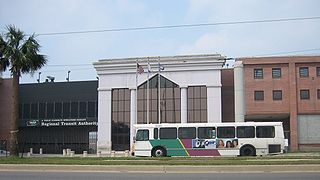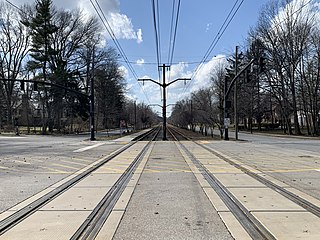
The New Orleans Regional Transit Authority is a public transportation agency based in New Orleans. The agency was established by the Louisiana State Legislature in 1979, and has operated bus and historic streetcar service throughout the city since 1983. With an annual ridership of over 18.6 million riders, the Regional Transit Authority is the largest public transit agency in the state of Louisiana.

A heritage railway or heritage railroad is a railway operated as living history to re-create or preserve railway scenes of the past. Heritage railways are often old railway lines preserved in a state depicting a period in the history of rail transport.

Streetcars in New Orleans have been an integral part of the city's public transportation network since the first half of the 19th century. The longest of New Orleans' streetcar lines, the St. Charles Avenue line, is the oldest continuously operating street railway system in the world. Today, the streetcars are operated by the New Orleans Regional Transit Authority (RTA).

The Ashmont–Mattapan High-Speed Line, commonly referred to as the Mattapan Trolley, is a partially grade-separated light rail line which forms part of the MBTA's Red Line rapid transit line. The line, which runs through Boston and Milton, Massachusetts, opened on August 26, 1929, as a conversion of a former commuter rail line. It exclusively uses PCC streetcars, supported by a maintenance team of blacksmiths and metalworkers who make parts for the historic rolling stock. Passengers must transfer at Ashmont to access the rest of the Red Line, which uses heavy rail metro rolling stock.

Thomas Built Buses, Inc. is an American bus manufacturer. Best known for its production of yellow school buses, Thomas produces other bus designs for a variety of usages. Currently, its production is concentrated on school buses and activity buses, along with their commercial derivatives.

The Boston Elevated Railway (BERy) was a streetcar and rapid transit railroad operated on, above, and below, the streets of Boston, Massachusetts and surrounding communities. Founded in 1894, it eventually acquired the West End Street Railway via lease and merger to become the city's primary mass transit provider. Its modern successor is the state-run Massachusetts Bay Transportation Authority (MBTA), which continues to operate in part on infrastructure developed by BERy and its predecessors.
Perley A. Thomas (1874–1958) was a Canadian-born American industrialist and entrepreneur. He was trained as a millsmith, and moved to Cleveland, Ohio, where he was employed by a streetcar manufacturer.

The J. G. Brill Company manufactured streetcars, interurban coaches, motor buses, trolleybuses and railroad cars in the United States for almost ninety years, making it the longest-lasting trolley and interurban manufacturer. At its height, Brill was the largest manufacturer of streetcars and interurban cars in the US and produced more streetcars, interurbans and gas-electric cars than any other manufacturer, building more than 45,000 streetcars alone.

Gillig is an American designer and manufacturer of buses. The company headquarters, along with its manufacturing operations, is located in Livermore, California. By volume, Gillig is the second-largest transit bus manufacturer in North America. As of 2013, Gillig had an approximate 31 percent market share of the combined United States and Canadian heavy-duty transit bus manufacturing industry, based on the number of equivalent unit deliveries.

Old Pueblo Trolley is a non-profit, educational corporation based in Tucson, in the U.S. state of Arizona, that is dedicated to the preservation of Arizona's mass transit history. The name also commonly refers to the heritage streetcar line which OPT began operating in 1993, on which service is currently indefinitely suspended. OPT consists of three divisions that each fill a specific role in preserving the state's mass transit history. The divisions are the Street Railway Division, Motor Bus Division and the Museum Division.

The Charlotte Trolley was a heritage streetcar that operated in Charlotte in the U.S. state of North Carolina. The line ran along the former Norfolk Southern right of way between Tremont Avenue in the Historic South End in a northerly direction to its terminus at 9th Street Uptown. It ran on tracks mostly shared with the LYNX Blue Line.

The St. Charles Streetcar Line is a historic streetcar line in New Orleans, Louisiana. Running since 1835, it is the oldest continuously operating streetcar line in the world. It is operated by the New Orleans Regional Transit Authority (RTA). Officially the St. Charles Streetcar line is designated as Route 12, and it runs along its namesake, St. Charles Avenue. It is the busiest route in the RTA system as it is heavily used by local commuters and tourists. On most RTA maps and publications, it is denoted in green, which is also the color of the streetcars on this line.

The Green Line is a light rail line of the RTA Rapid Transit system in Cleveland and Shaker Heights, Ohio, running from Tower City Center downtown, then east to Green Road near Beachwood. 2.6 miles (4.2 km) of track, including two stations, are shared with the rapid transit Red Line, the stations have low platforms for the Green Line and high platforms for the Red Line. The Green Line shares the right-of-way with the Blue Line in Cleveland, and splits off after passing through Shaker Square. All RTA light rail lines use overhead lines and pantographs to draw power.

The Shore Line Trolley Museum is a trolley museum located in East Haven, Connecticut. Incorporated in 1945, it is the oldest continuously operating trolley museum in the United States. The museum includes exhibits on trolley history in the visitors' center and offers rides on restored trolleys along its 1.5 mi (2.4 km) track as the Branford Electric Railway. In addition to trolleys, the museum also operates a small number of both trolleybuses and conventional buses.

The Pennsylvania Trolley Museum is a museum in Washington, Pennsylvania, dedicated to operation and preservation of streetcars and trolleys. The museum primarily contains historic trolleys from Pennsylvania, but their collection includes examples from nearby Toledo, Ohio; New Orleans, and even an open sided car from Brazil. Many have been painstakingly restored to operating condition. Other unique cars either waiting for restoration or incompatible with the Pennsylvania trolley gauge track are on display in a massive trolley display building. Notable examples on static display include a J.G. Brill “brilliner” car which was introduced as a competitor to the PCC, locomotives, and a horse car from the early days of Pittsburgh’s public transit systems.

The San Diego Metropolitan Transit System is a public transit service provider for Central, South, Northeast and Southeast San Diego County. The agency directly operates a large transit system that includes the MTS Bus, San Diego Trolley light rail, and Rapid bus rapid transit services. The MTS also controls the San Diego and Arizona Eastern (SD&AE) freight railway and regulates taxicabs, jitneys, and other private for-hire passenger transportation services.

Streetcars or trolley(car)s were once the chief mode of public transit in hundreds of North American cities and towns. Most of the original urban streetcar systems were either dismantled in the mid-20th century or converted to other modes of operation, such as light rail. Today, only Toronto still operates a streetcar network essentially unchanged in layout and mode of operation.

The Canal Streetcar Line is a historic streetcar line in New Orleans, Louisiana. It is operated by the New Orleans Regional Transit Authority (RTA). It originally operated from 1861 to 1964. It was redesigned and rebuilt between 2000 and 2004, and operation was reinstated in 2004 after a 40-year hiatus. Primarily running along its namesake street, Canal Street, it consists of two branches named for their outer terminals, totaling about 5+1⁄2 miles (8.9 km) in length: "Canal–Cemeteries" and "Canal–City Park/Museum". Each branch is denoted with the red and light green colors respectively on most RTA publications.

The Dayton trolleybus system forms part of the public transportation network serving Dayton, in the state of Ohio, United States. Opened on April 23, 1933, it presently comprises five lines, and is operated by the Greater Dayton Regional Transit Authority, with a fleet of 45 trolleybuses. In 2021, the system had a ridership of 1,786,900, or about 5,900 per weekday as of the third quarter of 2022.

The Riverfront Streetcar Line is a historic streetcar line in New Orleans, Louisiana. It is operated by the New Orleans Regional Transit Authority (RTA). It was built along the east bank of the Mississippi River, in an area with many amenities catering to tourists. It opened August 14, 1988, making it the first new streetcar route in New Orleans in 62 years. The line runs 2 miles (3.2 km) from Julia Street at the upper end of the New Orleans Convention Center to the downriver (far) end of the French Quarter at the foot of Esplanade Avenue. Unlike the other three lines, it travels on an exclusive right-of-way, along the river levee beside New Orleans Belt Railway tracks, making it more akin to a light rail line. The line was regauged in 1997 from standard gauge to broad gauge. Officially, the Riverfront Line is designated Route 2 and is designated with a blue color on most RTA publications.























